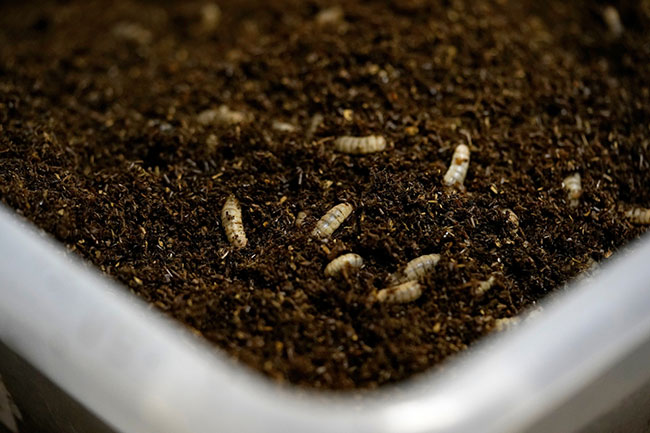
Features
Applications
Research
An appetite for manure
An entomologist shares insight into manure’s part in sustainable feed.
February 27, 2024 by Bree Rody
 Photo courtesy of Texas A&M AgriLife
Photo courtesy of Texas A&M AgriLife Manure’s value as a soil amendment is undeniable. But nevertheless, not everyone adopts manure application, even with the commercial fertilizer market as rocky as it is. The figures differ slightly across sources, but most research shows that manure is applied to 10 percent or less of U.S. cropland. As such, the natural result is more manure being produced than being applied.
That, of course, doesn’t mean manure is being wasted. Increasing adoption of manure application is an obvious goal; however, moving manure to where it’s needed is more complicated than most realize (for more on manuresheds, see our feature on Page 14). Thus, there are always additional uses for manure being explored – composting, bedding, renewable energy and digestate are just some of the other productive and practical uses of manure.
Another potential use? Feed.
No, livestock is not going to be chowing down on manure anytime soon. Instead, a team at Texas A&M University and Mississippi State University is looking at using black soldier flies (BSF) to transform manure into sustainable protein to fuel livestock.
“Understanding the need for sustainability is part of my DNA,” says Jeff Tomberlin, professor, AgriLife research fellow, presidential impact fellow and Center for Environmental Sustainability through Insect Farming director at Texas A&M. Tomberlin, one of the leaders on the project. As an entomologist, Tomberlin doesn’t regularly work with manure, admitting it’s a “fringe area” for him. But he has always known the potential of the BSF, and in his quest to do more, pushed himself into this area.
It was around the time that more of the farming community was beginning to see a degree or urgency in terms of being more conscious of taking care of the planet. But rather than take a scolding approach, Tomberlin says a collaborative approach that recognizes mutual interests is best. “Anything we can do in terms of diversity of income for farmers and provide stability is a good thing.”
Going into the study, Tomberlin and other experts already knew that the BSF would be able to digest manure. “What we know about its history is it’s commonly associated with animal waste – poultry manure, et cetera,” he says. It was first tested as a feed for rainbow trout, and studies found it did not affect the flavor of the trout.
What had not been tested at the time was industrializing it. “Can we make it more efficient, can we make it faster, can we make it more economical?”
The current study is looking solely at dairy manure. Currently, the hands-on research and data collection is occurring. The second and third year of the three-year project will look at data analysis and release. “We’ll look at everything from the ability of the insect to digest the waste and at what level and in combination with different microbes… and we’ll also be looking at the microbiome to see if there’s any pathogen associated with the waste, because we want to decrease the likelihood of pathogen movement.”
The team will be evaluating the speed of the insects converting the waste and how much of the waste is being converted to the biomass, how large the insects get, whether or not pathogens are present and levels of volatile emissions.
There are, nevertheless, limitations or regulations that can make implementation of insect feed at scale difficult. However, Tomberlin says the data gleaned from this research is exactly what is needed to increase adoption of insect feed, but a goal is also to find those in industry “to champion the idea.”
He adds that currently, cost of production of insect feed is “not where it needs to be” compared to feeds like alfalfa or soybean, but adds that research will help expand profit margins. “We’re doing [the project] at industrial scale. We’re not looking to translate [smaller scale] work to industrial scale.”
Insect-based feed for livestock is, indeed, an increasingly intriguing subject matter in the research and livestock community. But issues of scale, regulatory framework and public perception are still obstacles.
In a February 2023 interview with Manure Manager sister publication The Trough, Barbara Campbell, regional director, Atlantic Canada with National Products Canada (NPC), a non-profit company promoting early-stage innovation, says the industrial capacity required to move insect-based feed forward is moving forward. Currently, there are three large insect-based protein companies in Canada, five mid-size and over 20 smaller entities. Insect feed can be grown with a smaller footprint than grains, which some cite as an environmental advantage.
Industry benchmarking indicates for BFS larvae, a 100,000-square-foot facility processing 100 tonnes of organic waste daily represents a ‘really viable business’ says Campbell. “And can reach cost parity with fish meal on a high day… It’s exponentially more sustainable to produce protein this way.”
New entrants have opened in the last year in Drummondville, Que., London, Ont. and Peterborough, Ont. But the challenge lies in producers needing a commitment prior to investment – the scale is not yet there.
But ideally, says Tomberlin, it could work with small-scale dairy farmers and industrial alike – and small-scale dairy farmers could find themselves in an adventitious position, if the project is successful. “The more small-scale farmers you have doing it… if some succeed and some don’t, the variability associated with production is not as significant, versus if it’s one place that does it. If that place stops, it’s zero production. So I think this could be implemented at a small farmer scale, where you’re then lookingat a co-op production where you can consolidate production to meet demands.”